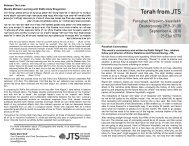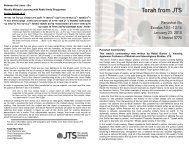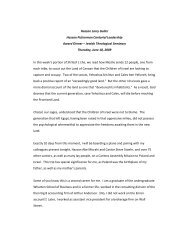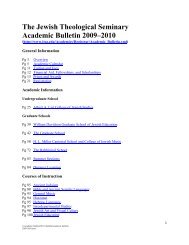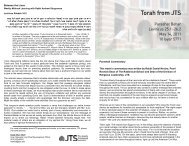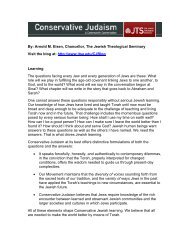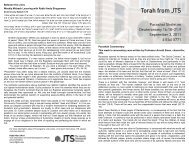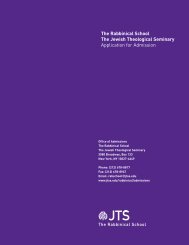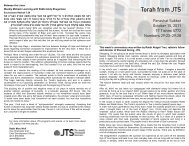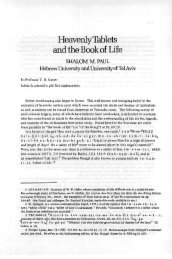On the Significance of a Name Change and Circumcision in Genesis ...
On the Significance of a Name Change and Circumcision in Genesis ...
On the Significance of a Name Change and Circumcision in Genesis ...
You also want an ePaper? Increase the reach of your titles
YUMPU automatically turns print PDFs into web optimized ePapers that Google loves.
<strong>On</strong> <strong>the</strong> <strong>Significance</strong> <strong>of</strong> a <strong>Name</strong> <strong>Change</strong><br />
<strong>and</strong> <strong>Circumcision</strong> <strong>in</strong> <strong>Genesis</strong> 17<br />
JOSEPH FLEISHMAN<br />
Bar-Ilan University<br />
<strong>Genesis</strong> 16 relates <strong>the</strong> sixth episode concern<strong>in</strong>g Abram: <strong>the</strong> birth <strong>of</strong> Ishmael,<br />
Abram’s first son. In chap. 17, <strong>the</strong> seventh episode, God <strong>in</strong>forms Abram that Ishmael,<br />
son <strong>of</strong> Hagar, will not be his spiritual heir (17:19); ra<strong>the</strong>r, a son named Isaac<br />
to whom Sarah will give birth, will be his heir. Just beforeh<strong>and</strong>, God had appeared<br />
to Abram <strong>and</strong> made him o<strong>the</strong>r promises. In addition to <strong>the</strong> promises <strong>in</strong> chap. 17, God<br />
changes Abram’s name to Abraham, <strong>and</strong> his wife’s name from Sarai to Sarah, <strong>and</strong><br />
comm<strong>and</strong>s Abraham to circumcise all <strong>the</strong> males belong<strong>in</strong>g to his household.<br />
The present study will <strong>in</strong>vestigate <strong>the</strong> question <strong>of</strong> why, at this particular time,<br />
<strong>the</strong> names <strong>of</strong> Abram <strong>and</strong> his wife were changed, <strong>and</strong> Abraham was comm<strong>and</strong>ed to<br />
undergo circumcision. We will try to show that <strong>the</strong> common denom<strong>in</strong>ator for both<br />
actions is that by means <strong>of</strong> <strong>the</strong>se acts Abram <strong>and</strong> his wife Sarai become worthy to<br />
beg<strong>in</strong> realiz<strong>in</strong>g Abraham’s dest<strong>in</strong>y <strong>in</strong> God’s plans as presented <strong>in</strong> God’s first revelation<br />
to Abram (12:1–3). The uncircumcised Abram could have a son Ishmael by<br />
Hagar, <strong>the</strong> slave-concub<strong>in</strong>e; but Isaac, <strong>the</strong> exclusive spiritual heir, was born to <strong>the</strong><br />
circumcised Abraham by his first wife, Sarah. Thus <strong>the</strong> seventh story <strong>of</strong> Abram/<br />
Abraham marks <strong>the</strong> ma<strong>in</strong> turn<strong>in</strong>g po<strong>in</strong>t for <strong>the</strong> realization <strong>of</strong> <strong>the</strong> seventh bless<strong>in</strong>g,<br />
which was given to Abraham at <strong>the</strong> time <strong>of</strong> God’s first revelation to him, namely,<br />
“<strong>and</strong> all <strong>the</strong> families <strong>of</strong> <strong>the</strong> earth shall bless <strong>the</strong>mselves by you” (12:3b).<br />
Scholars have noted <strong>the</strong> l<strong>in</strong>guistic <strong>and</strong> <strong>the</strong>matic similarity <strong>of</strong> <strong>the</strong> verses <strong>in</strong> <strong>the</strong><br />
first speech (Gen. 17:1–2) 1 to <strong>the</strong> first revelation to Abram as recorded <strong>in</strong> Gen. 12:1–<br />
4, to <strong>the</strong> covenant <strong>of</strong> Gen. 15, 2 <strong>and</strong> to <strong>the</strong> story <strong>of</strong> <strong>the</strong> b<strong>in</strong>d<strong>in</strong>g <strong>of</strong> Isaac <strong>in</strong> <strong>Genesis</strong> 22.<br />
However, it should be po<strong>in</strong>ted out that this section conta<strong>in</strong>s two new details that<br />
were not noted <strong>in</strong> prior stories about Abram:<br />
1. Chapter 17 consists <strong>of</strong> five speeches by God: 1) vv. 1b–2; 2) vv. 4–8; 3) vv. 9–14; 4) vv. 15–16;<br />
5) vv. 19–21. See, e.g., V. P. Hamilton, The Book <strong>of</strong> <strong>Genesis</strong> Chapters 1–17, NICOT (Gr<strong>and</strong> Rapids, 1990–<br />
91), 459; G. J. Wenham, <strong>Genesis</strong> 16–50, WBC (Dallas, 1994), 17. For a discussion <strong>of</strong> <strong>the</strong> importance <strong>of</strong><br />
<strong>the</strong> age <strong>of</strong> Abraham as a preparation for <strong>the</strong> stories about Abraham see, J. P. Fokkelman, “Time <strong>and</strong> Structure<br />
<strong>of</strong> <strong>the</strong> Abraham Cycle,” OTS 25 (1989), 96–101.<br />
2. See, e.g., J. Van Seters, Abraham <strong>in</strong> History <strong>and</strong> Tradition (New Haven–London, 1975), 282–84;<br />
C. Westermann, <strong>Genesis</strong> 12–36, trans. J. J. Scullion (Neukirchen-Vluyn, 1981), 25–27; T. D. Alex<strong>and</strong>er,<br />
“<strong>Genesis</strong> 22 <strong>and</strong> <strong>the</strong> Covenant <strong>of</strong> <strong>Circumcision</strong>,” JSOT 25 (1983), 17–22; Hamilton, <strong>Genesis</strong>, 463; Wenham,<br />
<strong>Genesis</strong>, 12, 17, 20; S. D. Kun<strong>in</strong>, The Logic <strong>of</strong> Incest, JSOT Supp. 185 (Sheffield, 1995), 60.<br />
Chap. 17 is ascribed by source critics to P while chap. 12 is assigned to J. Never<strong>the</strong>less it is proper to<br />
compare <strong>the</strong>m because “biblical texts had <strong>in</strong>tegrity to those who put <strong>the</strong>m toge<strong>the</strong>r.” See H. E. Goldberg,<br />
“Cambridge <strong>in</strong> <strong>the</strong> L<strong>and</strong> <strong>of</strong> Canaan: Descent <strong>and</strong> Alliance, <strong>Circumcision</strong> <strong>and</strong> Instruction <strong>in</strong> <strong>the</strong> Bible,”<br />
JANES 24 (1996), 4, <strong>and</strong> especially E. L. Greenste<strong>in</strong>, Essays on Biblical Method <strong>and</strong> Translation (Atlanta,<br />
1989), 29–51.<br />
<strong>On</strong>e L<strong>in</strong>e Long<br />
19
20<br />
JANES 28 (2001)<br />
1. God appears to Abram with a new name, “(I am) El Shaddai,” (Gen. 17:2).<br />
Though <strong>the</strong> etymology <strong>of</strong> this name is still a matter <strong>of</strong> dispute, 3 it is never<strong>the</strong>less<br />
quite clear that only now does God reveal to Abram a new aspect <strong>of</strong> div<strong>in</strong>ity. This<br />
name is <strong>the</strong> preferred name <strong>of</strong> God <strong>in</strong> <strong>the</strong> patriarchal narratives. 4<br />
2. God comm<strong>and</strong>s Abram: “Walk <strong>in</strong> My ways <strong>and</strong> be blameless,” <strong>and</strong> so <strong>in</strong>dicates to<br />
him that he must be absolutely loyal. 5 This dem<strong>and</strong> may suggest that despite <strong>the</strong><br />
fact that for 25 years Abram had demonstrated great loyalty to God, his loyalty<br />
was not yet considered absolute. 6<br />
The first revelation concludes by not<strong>in</strong>g that upon experienc<strong>in</strong>g <strong>the</strong> div<strong>in</strong>e vision,<br />
Abram fell on his face. The narrator thus shows <strong>the</strong> humility <strong>of</strong> Abram, his<br />
desire to hear <strong>the</strong> word <strong>of</strong> God, as well as his feel<strong>in</strong>gs at <strong>the</strong> moment <strong>of</strong> <strong>the</strong> revelation.<br />
7 Verses 1–3a prepare <strong>the</strong> reader for <strong>the</strong> metamorphosis that is about to take<br />
place <strong>in</strong> Abram.<br />
In <strong>the</strong> second speech (vv. 3–8), after God has promised Abram that he will become<br />
“<strong>the</strong> fa<strong>the</strong>r <strong>of</strong> a multitude <strong>of</strong> nations,” he changes his name from Abram to<br />
Abraham by add<strong>in</strong>g <strong>the</strong> letter he (aòòh), “for I have made you <strong>the</strong> fa<strong>the</strong>r <strong>of</strong> a multitude<br />
<strong>of</strong> nations” (v. 5c). 8 In <strong>the</strong> fourth speech (vv. 15–16) God changes Sarai’s name<br />
to Sarah, by chang<strong>in</strong>g <strong>the</strong> last letter to he (aòòh). Although no explanation is <strong>of</strong>fered<br />
3. For <strong>the</strong> various views, see J. Sk<strong>in</strong>ner, <strong>Genesis</strong>, ICC (Ed<strong>in</strong>burgh, 1912), 290–91; E. A. Speiser,<br />
<strong>Genesis</strong>, AB (Garden City, 1964), 124; Westermann, <strong>Genesis</strong>, 257–58; K. Koch, “Sadday, zum Verhältnis<br />
zwischen israelitischer Monolatrie und nordwest-semitischen Poly<strong>the</strong>ismus,” VT 26 (1976), 299–332,<br />
esp. 316–26; H. Niehr & G. Ste<strong>in</strong>s, “ydç saddaj,” Theologisches Wörterbuch zum Alten Testament, (Stuttgart–Berl<strong>in</strong>,<br />
1993), 7.1078–1104. For a discussion on <strong>the</strong> source <strong>of</strong> this name, see W. Wilfall, “El Shaddai<br />
or El <strong>of</strong> <strong>the</strong> fields,” ZAW 92 (1980), 24–32.<br />
4. This is also mentioned <strong>in</strong> Gen. 28:3; 34:14; 35:11; 48:3; 49:25. (All <strong>the</strong>se references are from <strong>the</strong><br />
Jacob narrative.) So, too, <strong>the</strong> tradition <strong>in</strong> Exod. 6:4 relates <strong>the</strong> names El-Shadday to <strong>the</strong> period <strong>of</strong> <strong>the</strong> patriarchs.<br />
See also I. Knohl, The Sanctuary <strong>of</strong> Silence (M<strong>in</strong>neapolis, 1995), 125, n. 3.<br />
5. G. von Rad, <strong>Genesis</strong>, OTL (London, 1970), 193–94; Westermann, <strong>Genesis</strong>, 259; N. M. Sarna, <strong>Genesis</strong>,<br />
The JPS Torah Commentary (Philadelphia, 1989), 122.<br />
The phrase ynpl ˚lhth “walk <strong>in</strong> my ways” parallels <strong>the</strong> common Akkadian phrase <strong>in</strong> <strong>the</strong> Assyrian<br />
texts, <strong>in</strong>a ma˙riya ittalak, <strong>and</strong> <strong>the</strong> comb<strong>in</strong>ation µymt hyhw “be perfect” is parallel to <strong>the</strong> phrase ittallaku<br />
salmis. See M. We<strong>in</strong>feld, Deuteronomy <strong>and</strong> <strong>the</strong> Deuteronomic School (Oxford, 1972), 76, <strong>and</strong> cf. CAD S/<br />
1, 255.<br />
Accord<strong>in</strong>g to <strong>Genesis</strong> Rabba 46:1 <strong>the</strong> term tamîm connotes that circumcision removes <strong>the</strong> blemish from<br />
<strong>the</strong> male person mak<strong>in</strong>g him a whole be<strong>in</strong>g, so to speak, <strong>in</strong> his relationship to God.<br />
6. Thus, for example, dur<strong>in</strong>g <strong>the</strong> fam<strong>in</strong>e <strong>in</strong> Canaan (12:10) he did not request God’s help, but left<br />
Canaan <strong>and</strong> went down to Egypt; also, when God promised him a son from Sarah, he threw himself on<br />
his face “<strong>and</strong> laughed, as he said to himself, ‘Can a child be born to a man a hundred years old, or can<br />
Sarah bear a child at n<strong>in</strong>ety?’” (17:17). From now on, his loyalty had to be absolute.<br />
7. Cf. Westermann, <strong>Genesis</strong>, 260; Wenham, <strong>Genesis</strong>, 21. For a detailed study <strong>of</strong> <strong>the</strong> symbolism <strong>of</strong><br />
fall<strong>in</strong>g on <strong>the</strong> face <strong>in</strong> <strong>the</strong> Bible <strong>and</strong> <strong>the</strong> ancient Near East, see M. Gruber, Aspects <strong>of</strong> Nonverbal Communication<br />
<strong>in</strong> <strong>the</strong> Ancient Near East, Studia Pohl 12/II (Rome, 1980), 133–36. For <strong>the</strong> voluntary reflexive<br />
nuance <strong>of</strong> lpn “fall” <strong>in</strong> such passages, see C. Cohen, “Jewish Medieval Commentary on <strong>the</strong> Book <strong>of</strong> <strong>Genesis</strong><br />
<strong>and</strong> Modern Biblical Philology,” JQR 81 (1990), 8–9; idem, “<strong>Genesis</strong> 14:1–11—An Early Israelite<br />
Chronographic Source,” <strong>in</strong> K. Lawson Younger et al., eds., The Biblical Canon <strong>in</strong> Comparative Perspective<br />
(New York, 1991), 76–77.<br />
8. The narrator changed <strong>the</strong> name <strong>of</strong> Abram prior to <strong>the</strong> promises described <strong>in</strong> vv. 7–8. We have here<br />
a performative utterance, i.e., <strong>the</strong> words recited constitute <strong>the</strong> very action to which <strong>the</strong>y refer. For <strong>the</strong> usage,<br />
see W. von Soden, Grundriss der akkadischen Grammatik, 3d ed. (Roma, 1995), 130 (§80c).
Fleishman: <strong>Name</strong> <strong>Change</strong> <strong>and</strong> <strong>Circumcision</strong> <strong>in</strong> <strong>Genesis</strong> 17 21<br />
for this change <strong>of</strong> name, God promises “For I will bless her so that she shall give<br />
rise to nations; rulers <strong>of</strong> people shall issue from her” (v. 16b). 9 In <strong>the</strong> third speech<br />
(vv. 9–14), as <strong>in</strong> <strong>the</strong> first one, <strong>the</strong> emphasis is placed on God’s dem<strong>and</strong>s from Abraham.<br />
Abraham is comm<strong>and</strong>ed to circumcise all <strong>the</strong> males that belong to his household.<br />
This dem<strong>and</strong> is directed at Abraham <strong>and</strong> his descendants for all generations.<br />
<strong>Circumcision</strong> is <strong>the</strong> sign <strong>of</strong> <strong>the</strong> everlast<strong>in</strong>g covenant between God <strong>and</strong> Abraham <strong>and</strong><br />
his descendants (17:11, 13), <strong>and</strong> he who does not circumcise will be cut <strong>of</strong>f because<br />
he has violated <strong>the</strong> covenant <strong>of</strong> God (v. 14). 10 Why, precisely at this stage <strong>of</strong> life,<br />
did God change <strong>the</strong> names <strong>of</strong> Abraham <strong>and</strong> his wife (<strong>the</strong> first name change <strong>in</strong> <strong>the</strong><br />
Book <strong>of</strong> <strong>Genesis</strong>), <strong>and</strong> comm<strong>and</strong> Abraham <strong>and</strong> all <strong>the</strong> males <strong>of</strong> his family to undergo<br />
circumcision?<br />
In <strong>the</strong> Bible <strong>and</strong> <strong>in</strong> ancient Near Eastern cultures a name served not only as a<br />
means <strong>of</strong> personal identification, but also as a cultural <strong>and</strong> religious marker, creat<strong>in</strong>g<br />
a l<strong>in</strong>k between <strong>the</strong> bearer <strong>of</strong> <strong>the</strong> name <strong>and</strong> associations l<strong>in</strong>ked to that name. Thus <strong>the</strong><br />
giv<strong>in</strong>g <strong>of</strong> a name or chang<strong>in</strong>g it had great significance. 11<br />
The etymology <strong>of</strong> <strong>the</strong> name Abram is a matter <strong>of</strong> dispute. 12 However, despite<br />
<strong>the</strong> lack <strong>of</strong> certa<strong>in</strong>ty concern<strong>in</strong>g <strong>the</strong> orig<strong>in</strong>al mean<strong>in</strong>g <strong>of</strong> <strong>the</strong> name, <strong>the</strong> reader assumes<br />
that s<strong>in</strong>ce Abram was given his name by Terah, <strong>the</strong> name established a connection<br />
between Abram <strong>and</strong> Terah’s culture. 13 Thus it is significant that 25 years<br />
after leav<strong>in</strong>g Mesopotamia <strong>in</strong> accordance with God’s comm<strong>and</strong>, Abram still bore <strong>the</strong><br />
name that ma<strong>in</strong>ta<strong>in</strong>ed a l<strong>in</strong>k to his former culture <strong>and</strong> belief.<br />
The new name, Abraham, is <strong>in</strong>terpreted as “fa<strong>the</strong>r <strong>of</strong> a multitude <strong>of</strong> nations”<br />
(17:4–5). This is nei<strong>the</strong>r <strong>the</strong> literal nor <strong>the</strong> etymological mean<strong>in</strong>g, but phonemically<br />
it is similar “to ’ab hamon, attested to <strong>in</strong> <strong>the</strong> repetition ’ab <strong>and</strong> ham <strong>in</strong> both <strong>the</strong> name<br />
<strong>and</strong> <strong>the</strong> explanation.” 14 The letter resh (çòòyr) does not appear <strong>in</strong> <strong>the</strong> explanation. It<br />
is a flexible “literary” etymology, which takes no account <strong>of</strong> l<strong>in</strong>guistic differences<br />
between <strong>the</strong> name <strong>and</strong> <strong>the</strong> proposed explanation. 15 The expansion <strong>of</strong> <strong>the</strong> name<br />
9. For a discussion <strong>of</strong> <strong>the</strong> names Sarai/Sarah, see, e.g., Van Seters, Abraham <strong>in</strong> History, 42; Wenham,<br />
<strong>Genesis</strong>, 30.<br />
10. <strong>On</strong> <strong>the</strong> significance <strong>of</strong> <strong>the</strong> penalty <strong>of</strong> karet, see below.<br />
11. See, e.g., J. Pedersen, Israel: Its Life <strong>and</strong> Culture (London–Copenhagen, 1926), 1.213–24; R. Abba,<br />
“<strong>Name</strong>,” Interpreter’s Dictionary <strong>of</strong> <strong>the</strong> Bible (New York–Nashville, 1962), 3.500–502; G. W. Ramsey,<br />
“Is <strong>Name</strong> Giv<strong>in</strong>g an Act <strong>of</strong> Dom<strong>in</strong>ation <strong>in</strong> <strong>Genesis</strong> 2:23 <strong>and</strong> Elsewhere?” CBQ 50 (1988), 24–35; Sarna,<br />
<strong>Genesis</strong>, 124; Hamilton, <strong>Genesis</strong>, 463–64; Wenham, <strong>Genesis</strong>, 21. The importance which <strong>the</strong> Bible ascribes<br />
to names f<strong>in</strong>ds its best expression <strong>in</strong> <strong>the</strong> comprehensive study <strong>of</strong> M. Garsiel, Biblical <strong>Name</strong>s (Ramat Gan,<br />
1991).<br />
12. See, e.g., S. R. Driver, The Book <strong>of</strong> <strong>Genesis</strong> (London, 1984), 185; Sk<strong>in</strong>ner, <strong>Genesis</strong>, 244; L. Hicks,<br />
“Abraham,” Interpreter’s Dictionary <strong>of</strong> <strong>the</strong> Bible (New York–Nashville, 1962), 1.15; A. R. Millard, “Abraham,”<br />
ABD (New York–London, 1992), 1.39; Hamilton, <strong>Genesis</strong>, 464; T. L. Thompson, The Historicity<br />
<strong>of</strong> <strong>the</strong> Patriarchal Narratives, BZAW 133 (Berl<strong>in</strong>–New York, 1974), 22–36; Van Seters, Abraham <strong>in</strong> History,<br />
40–42.<br />
13. See W. F. Albright, “The <strong>Name</strong> Shaddai <strong>and</strong> Abram,” JBL 54 (1935), 193–204; J. J. Stamm, Die<br />
akkadische <strong>Name</strong>ngebung, MVAG 44 (Darmstadt, 1932), 54–56; K. van der Toorn, “Ancestors <strong>and</strong> Anthroponyms:<br />
K<strong>in</strong>ship Terms as Theophoric Elements <strong>in</strong> Hebrew <strong>Name</strong>s,” ZAW 108 (1996), 3–4.<br />
14. Hamilton, <strong>Genesis</strong>, 464.<br />
15. Garsiel, Biblical <strong>Name</strong>s, 18. There are scholars who ma<strong>in</strong>ta<strong>in</strong> that <strong>the</strong> letter he (aòòh) here might<br />
be some type <strong>of</strong> <strong>in</strong>ternal plural. See J. A. Montgomery, “The hemzah-h <strong>in</strong> Semitic,” JBL 46 (1927), 144–<br />
46; J. Huehnergard, “Three Notes on Akkadian Morphology,” <strong>in</strong> D. M. Golomb, ed., Work<strong>in</strong>g with No
22<br />
JANES 28 (2001)<br />
Abram might create a direct l<strong>in</strong>k to God’s promise <strong>in</strong> Gen. 12:2: “I will make your<br />
name great.” 16<br />
Scholars ma<strong>in</strong>ta<strong>in</strong> that <strong>the</strong> names <strong>of</strong> Abram <strong>and</strong> Sarai were changed <strong>in</strong> order to<br />
mark <strong>the</strong> promise <strong>of</strong> many descendants. 17 We suggest ano<strong>the</strong>r reason for <strong>the</strong> name<br />
change.<br />
The explanation for <strong>the</strong> new name <strong>of</strong> Abraham def<strong>in</strong>es his dest<strong>in</strong>y. The purpose<br />
<strong>of</strong> Abram’s election was already revealed <strong>in</strong> <strong>the</strong> first revelation when God told him,<br />
“Go forth from your native l<strong>and</strong> <strong>and</strong> your k<strong>in</strong>dred <strong>and</strong> from your fa<strong>the</strong>r’s house”<br />
(12:1a), namely, he was told to detach himself from all frameworks to which he previously<br />
belonged. 18 The graduated formulation <strong>of</strong> <strong>the</strong> frameworks he was to leave,<br />
was apparently <strong>in</strong>tended not only to stress that God was aware <strong>of</strong> Abraham’s personal<br />
difficulty <strong>in</strong> fulfill<strong>in</strong>g this comm<strong>and</strong>, 19 but also Abram’s <strong>in</strong>timate connection<br />
with <strong>the</strong>se frameworks. The reader learns that he did not will<strong>in</strong>gly <strong>and</strong> easily detach<br />
himself from <strong>the</strong>m; nei<strong>the</strong>r did he do so because <strong>of</strong> conflicts like <strong>the</strong> separation<br />
from Lot (chap. 13). An absolute physical separation was necessary to enable him to<br />
detach himself from his former culture. <strong>On</strong>ly after such detachment was he to receive<br />
<strong>the</strong> seven promises related <strong>in</strong> 12:2–3. These promises are <strong>of</strong> great importance<br />
for underst<strong>and</strong><strong>in</strong>g <strong>the</strong> relations between God <strong>and</strong> humanity <strong>in</strong> <strong>Genesis</strong> <strong>in</strong> general,<br />
Abram’s dest<strong>in</strong>y <strong>in</strong> particular, 20 <strong>and</strong> especially <strong>the</strong> seventh promise, which was <strong>the</strong><br />
gr<strong>and</strong> f<strong>in</strong>ale <strong>of</strong> <strong>the</strong> promises <strong>and</strong> <strong>the</strong> announcement <strong>of</strong> God’s program. 21 As von Rad<br />
has noted: “This prophecy <strong>in</strong> chap. 12.3b reaches far out toward <strong>the</strong> goal <strong>of</strong> God’s<br />
plan for history . . . It is enough that <strong>the</strong> goal is announced, <strong>and</strong> that it suggests <strong>the</strong><br />
mean<strong>in</strong>g <strong>of</strong> <strong>the</strong> road that God has taken by call<strong>in</strong>g Abraham.” 22<br />
This promise conta<strong>in</strong>s with<strong>in</strong> it <strong>the</strong> first h<strong>in</strong>t <strong>of</strong> <strong>the</strong> universality <strong>of</strong> Israel’s belief<br />
that was afterwards developed by <strong>the</strong> teach<strong>in</strong>gs <strong>of</strong> <strong>the</strong> prophets. 23<br />
The selection <strong>of</strong> Abraham is <strong>the</strong> turn<strong>in</strong>g po<strong>in</strong>t not only <strong>in</strong> <strong>the</strong> story <strong>of</strong> humanity,<br />
but also <strong>in</strong> God’s plan to redeem humanity from its current situation through Abraham<br />
<strong>and</strong> his descendants, that is, Israel. As Wright expla<strong>in</strong>s:<br />
Data: Semitic <strong>and</strong> Egyptian Studies Presented to Thomas O. Lambd<strong>in</strong> (W<strong>in</strong>ona Lake, Indiana, 1987), 181–<br />
82; Hamilton, <strong>Genesis</strong>, 464. Ibn Ezra proposes to see here a notariqon (ABiR (mighty one) + HaMon<br />
(multitude) + goyim (nations); cf. Sarna, <strong>Genesis</strong>, 124.<br />
There are a number <strong>of</strong> key words <strong>in</strong> vv. 4–8, such as tyrb ,hbr ,hrp, which conta<strong>in</strong> consonants that are<br />
similar to <strong>the</strong> consonants <strong>in</strong> <strong>the</strong> name Abraham. See A. Strus, Nomen-Omen: La stylistique sonore dans<br />
noms propres dans le Pentateuque (Rome, 1978), 106–7; Wenham, <strong>Genesis</strong>, 210, considers that <strong>the</strong> phraseology<br />
<strong>in</strong> Gen. 17:1, “I will greatly <strong>in</strong>crease your seed,” is an anagram <strong>of</strong> <strong>the</strong> name Abraham.<br />
16. Sarna, <strong>Genesis</strong>, 124.<br />
17. E.g., Hamilton, <strong>Genesis</strong>, 463; Wenham, <strong>Genesis</strong>, 17, 28. Kun<strong>in</strong> (The Logic, 65, 76) ma<strong>in</strong>ta<strong>in</strong>s that<br />
this is an <strong>in</strong>dication <strong>of</strong> <strong>the</strong> div<strong>in</strong>e birth <strong>of</strong> Abraham. We will discuss this <strong>the</strong>sis below.<br />
18. Driver, <strong>Genesis</strong>, 145; Sk<strong>in</strong>ner, <strong>Genesis</strong>, 243; Speiser, <strong>Genesis</strong>, 86; von Rad, <strong>Genesis</strong>, 154; P. D.<br />
Miller, “Syntax <strong>and</strong> Theology <strong>in</strong> <strong>Genesis</strong> XII 3a,” VT 34 (1984), 472–75.<br />
19. Von Rad, <strong>Genesis</strong>, 154; Sarna, <strong>Genesis</strong>, 88.<br />
20. See, e.g., Midrash Rabba 39:11; Sk<strong>in</strong>ner, <strong>Genesis</strong>, 243; Wenham, <strong>Genesis</strong>, 274–77; J. B. Wells,<br />
God’s Holy People, JSOT Supp. 305 (Sheffield, 2000), 185–204.<br />
21. Hamilton, <strong>Genesis</strong>, 374.<br />
22. <strong>Genesis</strong>, 156.<br />
23. M. D. Cassuto, A Commentary on <strong>the</strong> Book <strong>of</strong> <strong>Genesis</strong> (Jerusalem, 1974), 215 [<strong>in</strong> Hebrew]; Westermann,<br />
<strong>Genesis</strong>, 151–52. See also Sk<strong>in</strong>ner, <strong>Genesis</strong>, 243; Speiser, <strong>Genesis</strong>, 86; von Rad, <strong>Genesis</strong>, 156.
Fleishman: <strong>Name</strong> <strong>Change</strong> <strong>and</strong> <strong>Circumcision</strong> <strong>in</strong> <strong>Genesis</strong> 17 23<br />
The creation <strong>of</strong> <strong>the</strong> nation <strong>of</strong> Israel was God’s answer to <strong>the</strong> fall <strong>of</strong> mank<strong>in</strong>d. This is apparent<br />
<strong>in</strong> <strong>the</strong> open<strong>in</strong>g <strong>of</strong> <strong>the</strong> redemption history with <strong>the</strong> call <strong>of</strong> Abraham <strong>in</strong> Gen. 12 com<strong>in</strong>g immediately<br />
after <strong>the</strong> “global” effects <strong>of</strong> mank<strong>in</strong>d’s s<strong>in</strong> <strong>and</strong> arrogance, as typified <strong>in</strong> <strong>the</strong> story <strong>of</strong><br />
Babel with which <strong>the</strong> “primal history” closes. Abraham’s seed will be <strong>the</strong> nation among <strong>the</strong><br />
nations for <strong>the</strong> nations, <strong>the</strong> vehicle <strong>of</strong> God’s redemptive purpose, <strong>the</strong> “prototype” <strong>of</strong> God’s<br />
redeemed mank<strong>in</strong>d. 24<br />
Abraham immediately acted upon God’s comm<strong>and</strong>: he left Mesopotamia, tak<strong>in</strong>g<br />
with him his wife Sarai, <strong>and</strong> his nephew Lot. By tak<strong>in</strong>g along Sarai <strong>and</strong> Lot, he<br />
did not disobey God’s comm<strong>and</strong> to completely detach himself from his relatives, for<br />
<strong>the</strong>y were an <strong>in</strong>tegral part <strong>of</strong> <strong>the</strong> household he headed. 25<br />
Accord<strong>in</strong>g to <strong>the</strong> mean<strong>in</strong>g <strong>of</strong> <strong>the</strong> term µç, “name,” <strong>in</strong> <strong>the</strong> Bible, <strong>and</strong> accord<strong>in</strong>g<br />
to <strong>the</strong> def<strong>in</strong>ition <strong>of</strong> Abram’s goal, it is possible to propose a reason for <strong>the</strong> name<br />
change at this particular stage <strong>of</strong> his life. The name Abram <strong>in</strong>dicates that <strong>the</strong> bearer<br />
<strong>of</strong> <strong>the</strong> name has not yet achieved adequate separation from his former religiocultural<br />
milieu. God did not nullify Abram’s orig<strong>in</strong>al name, as a master was accustomed<br />
to do<strong>in</strong>g <strong>in</strong> similar situations (e.g., 2 Kgs. 23:34; 24:17). Nor did God<br />
cont<strong>in</strong>ue to use <strong>the</strong> orig<strong>in</strong>al name after <strong>the</strong> new one was given, as God did <strong>in</strong> <strong>the</strong><br />
case <strong>of</strong> Jacob after nam<strong>in</strong>g him “Israel” (Gen. 32:28; 35:10). 26 God simply added one<br />
letter to Abram’s name, <strong>the</strong>reby tak<strong>in</strong>g him out <strong>of</strong> <strong>the</strong> cultural-religious milieu he<br />
had been liv<strong>in</strong>g <strong>in</strong>, yet hav<strong>in</strong>g him preserve a certa<strong>in</strong> aff<strong>in</strong>ity with his past, so that<br />
Abraham could fulfill his dest<strong>in</strong>y to become “<strong>the</strong> fa<strong>the</strong>r <strong>of</strong> a multitude <strong>of</strong> nations.”<br />
The name change for Abraham was thus a fur<strong>the</strong>r, not yet f<strong>in</strong>al stage, <strong>in</strong> dissociat<strong>in</strong>g<br />
him from his former heritage. The f<strong>in</strong>al stage, it is suggested, is <strong>the</strong> observance <strong>of</strong><br />
<strong>the</strong> comm<strong>and</strong>ment <strong>of</strong> circumcision.<br />
Kun<strong>in</strong> <strong>of</strong>fers an <strong>in</strong>terest<strong>in</strong>g explanation for <strong>the</strong> connection between a name<br />
change <strong>and</strong> circumcision. In his op<strong>in</strong>ion:<br />
The Covenant <strong>of</strong> <strong>Circumcision</strong> is <strong>the</strong> third “div<strong>in</strong>e birth” text. It conta<strong>in</strong>s structural elements<br />
that jo<strong>in</strong> it with <strong>the</strong> o<strong>the</strong>r two . . . It conta<strong>in</strong>s a symbolic sacrifice, circumcision (which also<br />
may be a symbolic castration). The element <strong>of</strong> “new beg<strong>in</strong>n<strong>in</strong>g” is also emphasized through<br />
<strong>the</strong> change <strong>in</strong> Abram’s name to Abraham. 27<br />
Kun<strong>in</strong>’s <strong>the</strong>sis raises a number <strong>of</strong> questions—such as why was <strong>the</strong>re a need for<br />
three “div<strong>in</strong>e birth” stories regard<strong>in</strong>g one person—but that is beyond <strong>the</strong> realm <strong>of</strong><br />
this study. <strong>Circumcision</strong> is specifically def<strong>in</strong>ed <strong>in</strong> chap. 17 as a sign <strong>of</strong> <strong>the</strong> covenant<br />
between God <strong>and</strong> Abraham <strong>and</strong> <strong>the</strong> latter’s descendants. 28 Therefore, one can<br />
underst<strong>and</strong> <strong>the</strong> essence <strong>of</strong> <strong>the</strong> circumcision, as well as <strong>the</strong> connection between <strong>the</strong><br />
name change <strong>and</strong> circumcision <strong>in</strong> <strong>the</strong> light <strong>of</strong> <strong>the</strong> term “covenant” that <strong>in</strong> ancient<br />
Near Eastern writ<strong>in</strong>gs <strong>and</strong> <strong>in</strong> <strong>the</strong> Bible def<strong>in</strong>es a b<strong>in</strong>d<strong>in</strong>g obligatory <strong>and</strong> mutual<br />
24. C. J. H. Wright, God’s People <strong>in</strong> God’s L<strong>and</strong> (Gr<strong>and</strong> Rapids–Exeter, 1990), 174–75.<br />
25. Von Rad, <strong>Genesis</strong>, 157. Apparently, Abram did not underst<strong>and</strong> that leav<strong>in</strong>g <strong>the</strong> o<strong>the</strong>r frameworks<br />
he was comm<strong>and</strong>ed to leave (12:1) obligated him to cease all relations with <strong>the</strong> family, as can be concluded,<br />
for example <strong>in</strong> <strong>the</strong> story <strong>in</strong> <strong>Genesis</strong> 24.<br />
26. This issue will not be discussed <strong>in</strong> <strong>the</strong> present study.<br />
27. Kun<strong>in</strong>, The Logic, 63, 72. He is <strong>of</strong> <strong>the</strong> op<strong>in</strong>ion that Gen. 12:1–3 <strong>and</strong> chap. 16 are “div<strong>in</strong>e birth”<br />
texts. For his def<strong>in</strong>ition <strong>of</strong> “div<strong>in</strong>e birth,” see p. 36, n. 1.<br />
28. “My covenant” is mentioned n<strong>in</strong>e times (vv. 2, 4, 7, 9, 10, 13, 14, 19, 21); “everlast<strong>in</strong>g covenant,”<br />
three times (vv. 7, 13, 19); “sign <strong>of</strong> <strong>the</strong> covenant” once (v. 11).
24<br />
JANES 28 (2001)<br />
relationship between two parties. 29 Moreover, <strong>in</strong> passages <strong>in</strong> <strong>Genesis</strong> that are attributed<br />
by source critics to P, <strong>the</strong> term “covenant” marks a promise <strong>of</strong> God to man that<br />
is conditional upon fulfill<strong>in</strong>g God’s comm<strong>and</strong>ments. 30 Likewise <strong>in</strong> chap. 17 God’s<br />
promises depend upon fulfill<strong>in</strong>g <strong>the</strong> covenant <strong>of</strong> circumcision. Consequently, it<br />
seems to us that <strong>the</strong> story <strong>in</strong> chap. 17 should not be understood with<strong>in</strong> <strong>the</strong> framework<br />
<strong>of</strong> “div<strong>in</strong>e birth,” but ra<strong>the</strong>r with<strong>in</strong> <strong>the</strong> framework <strong>of</strong> <strong>the</strong> special covenantal<br />
relations between God <strong>and</strong> Abraham.<br />
God made two everlast<strong>in</strong>g promises to Abraham: a) “to be God to you <strong>and</strong> to<br />
your <strong>of</strong>fspr<strong>in</strong>g to come” (Gen. 17:7b); b) to “give <strong>the</strong> l<strong>and</strong> you sojourn <strong>in</strong> to you <strong>and</strong><br />
your <strong>of</strong>fspr<strong>in</strong>g to come, all <strong>the</strong> l<strong>and</strong> <strong>of</strong> Canaan, as an everlast<strong>in</strong>g possession”<br />
(17:8b). Both promises are conditioned upon <strong>the</strong> observance <strong>of</strong> <strong>the</strong> comm<strong>and</strong> <strong>of</strong> circumcision,<br />
by which loyalty to <strong>the</strong> covenant with God is expressed. Anyone who<br />
does not observe <strong>the</strong> comm<strong>and</strong> is to be cut <strong>of</strong>f from his people (v. 14). 31<br />
It is well known that <strong>the</strong> act <strong>of</strong> circumcision is not unique to Abraham <strong>and</strong> his<br />
descendants. Many peoples at different times, <strong>in</strong> <strong>the</strong> Near East <strong>and</strong> <strong>in</strong> o<strong>the</strong>r parts <strong>of</strong><br />
<strong>the</strong> world, have required male circumcision. 32 <strong>Circumcision</strong> <strong>in</strong> <strong>the</strong> ancient Near East<br />
was performed <strong>in</strong> one <strong>of</strong> two ways: ei<strong>the</strong>r by mak<strong>in</strong>g a cut <strong>in</strong> <strong>the</strong> foresk<strong>in</strong> so that it<br />
rema<strong>in</strong>ed hang<strong>in</strong>g freely, or by entirely remov<strong>in</strong>g <strong>the</strong> foresk<strong>in</strong>. 33 There are differences<br />
<strong>of</strong> op<strong>in</strong>ion as to <strong>the</strong> orig<strong>in</strong>s <strong>of</strong> <strong>the</strong> practice. Some scholars ma<strong>in</strong>ta<strong>in</strong> that <strong>the</strong><br />
custom arose <strong>in</strong> Egypt <strong>and</strong> spread from <strong>the</strong>re to various o<strong>the</strong>r cultures. 34 However,<br />
accord<strong>in</strong>g to Sasson <strong>the</strong> source <strong>of</strong> <strong>the</strong> custom was Northwest Semitic <strong>and</strong> <strong>the</strong> Egyptians<br />
adopted it from <strong>the</strong>re. 35 There is also no consensus regard<strong>in</strong>g <strong>the</strong> reason that<br />
circumcision developed <strong>in</strong> <strong>the</strong> various cultures. The pr<strong>in</strong>cipal views are: a) circumcision<br />
was a ritual whose purpose was to guarantee fertility, or it was part <strong>of</strong> <strong>the</strong><br />
marriage ceremony thus be<strong>in</strong>g l<strong>in</strong>ked to fertility; b) it had apotropaic functions; c) it<br />
was a symbol <strong>of</strong> covenant confirmation. 36 Fox seems to be correct that one cannot<br />
be certa<strong>in</strong> <strong>of</strong> <strong>the</strong> orig<strong>in</strong>al reason for <strong>the</strong> practice among <strong>the</strong> Semitic peoples <strong>and</strong><br />
among <strong>the</strong> non-Semitic peoples who practiced circumcision, 37 but it is very likely<br />
29. See, e.g., G. E. Mendenhall <strong>and</strong> G. H. Herion, “Covenant,” ABD (New York–London, 1992),<br />
1.1179–1202.<br />
30. Knohl, The Sanctuary, 141–42, <strong>and</strong> nn. 65–66. For a similar conditional grant, see M. We<strong>in</strong>feld,<br />
“The Covenant <strong>of</strong> Grant <strong>in</strong> <strong>the</strong> Old Testament <strong>and</strong> <strong>in</strong> <strong>the</strong> Ancient Near East,” JAOS 90 (1970), 184–203.<br />
31. The <strong>in</strong>stances <strong>of</strong> this formula <strong>in</strong> <strong>the</strong> Torah are listed <strong>in</strong> Mishnah Keritot 1:1. For exegesis which<br />
analyzes <strong>the</strong> karet <strong>in</strong> <strong>the</strong> Torah see, e.g., B. A. Lev<strong>in</strong>e, Leviticus, The JPS Torah Commentary (Philadelphia–<br />
New York–Jerusalem, 1989), 241–42 (= Excursus 1); J. Milgrom, Numbers, JPS Torah Commentary<br />
(Philadelphia–New York–Jerusalem, 1989) 405–8 (= Excursus 36). See also W. Horbury, “Extirpation <strong>and</strong><br />
Excommunication,” VT 35 (1995), 13–38, esp. 31–34; Hamilton, <strong>Genesis</strong>, 473–74 <strong>and</strong> <strong>the</strong> literature listed<br />
<strong>in</strong> nn. 20–23; G. F. Hasel, “trk karat,” TDOT (Gr<strong>and</strong> Rapids, Michigan, 1995), 7.347–49.<br />
32. See Jer. 9:24–25; Ezek. 28:10; 32:21–30. M. V. Fox, “The Sign <strong>of</strong> <strong>the</strong> Covenant,” RB 81 (1974),<br />
551, 589, 592; Westermann, <strong>Genesis</strong>, 265; Sarna, <strong>Genesis</strong>, 125; Hamilton, <strong>Genesis</strong>, 469, <strong>and</strong> see list <strong>of</strong><br />
scholarly literature <strong>in</strong> notes 11–12; R. G. Hall, “<strong>Circumcision</strong>,” ABD (New York–London, 1992), 1.1025–<br />
31. For a comprehensive survey <strong>of</strong> circumcision <strong>in</strong> various cultures <strong>and</strong> possible reasons for it, see<br />
R. Romberg, <strong>Circumcision</strong> (Massachusetts, 1985), 4–13; H. Eilberg-Schwartz, The Savage <strong>in</strong> Judaism<br />
(Bloom<strong>in</strong>gton–Indianapolis, 1990), 141–49.<br />
33. Hall, “<strong>Circumcision</strong>,” 1025.<br />
34. Loc. cit. <strong>On</strong> circumcision <strong>in</strong> Egypt <strong>and</strong> its purposes, see Fox, “The Sign <strong>of</strong> <strong>the</strong> Covenant,” 592.<br />
35. J. M. Sasson, “<strong>Circumcision</strong> <strong>in</strong> <strong>the</strong> Ancient Near East,” JBL 85 (1966), 473–76.<br />
36. Hall, “<strong>Circumcision</strong>,” 1026. For more studies on <strong>the</strong> practice <strong>and</strong> mean<strong>in</strong>g <strong>of</strong> circumcision, see<br />
Hamilton, <strong>Genesis</strong>, 469, n. 12.<br />
<strong>On</strong>e L<strong>in</strong>e Long
Fleishman: <strong>Name</strong> <strong>Change</strong> <strong>and</strong> <strong>Circumcision</strong> <strong>in</strong> <strong>Genesis</strong> 17 25<br />
that <strong>the</strong> act <strong>of</strong> circumcision was performed on <strong>the</strong> male sexual organ because it was<br />
thought to have some l<strong>in</strong>k to fertility.<br />
<strong>Circumcision</strong> as comm<strong>and</strong>ed to Abraham differs from circumcision rites <strong>of</strong><br />
o<strong>the</strong>r cultures <strong>in</strong> that <strong>the</strong> male child was to be circumcised on <strong>the</strong> eighth day after<br />
birth (Gen. 17:12), 38 <strong>and</strong> it symbolizes a covenant with God. Thus <strong>in</strong> <strong>Genesis</strong> 17<br />
circumcision serves as a “sign <strong>of</strong> <strong>the</strong> covenant,” namely, a fixed sign <strong>in</strong> <strong>the</strong> sexual<br />
organ <strong>of</strong> all male descendants <strong>of</strong> Abraham whose aim was to mark <strong>the</strong> covenant between<br />
God <strong>and</strong> <strong>the</strong> descendants <strong>of</strong> Abraham. 39<br />
There are those who ma<strong>in</strong>ta<strong>in</strong> that circumcision is a “sign <strong>of</strong> <strong>the</strong> covenant”<br />
much like <strong>the</strong> ra<strong>in</strong>bow (Gen. 9:12–17) whose aim is to rem<strong>in</strong>d God, not man, <strong>of</strong> <strong>the</strong><br />
covenant with <strong>the</strong> descendants <strong>of</strong> Abraham or with respect to all humanity. This<br />
op<strong>in</strong>ion ma<strong>in</strong>ta<strong>in</strong>s that P believes <strong>in</strong> <strong>the</strong> need for rem<strong>in</strong>ders to God. 40<br />
It is highly doubtful that <strong>the</strong> aim <strong>of</strong> <strong>the</strong> sign <strong>of</strong> <strong>the</strong> ra<strong>in</strong>bow is to rem<strong>in</strong>d God not<br />
to br<strong>in</strong>g a flood upon humanity. The ra<strong>in</strong>bow does not appear at <strong>the</strong> beg<strong>in</strong>n<strong>in</strong>g <strong>of</strong> <strong>the</strong><br />
storm but at its end. 41 Fox is compelled to admit, “at any rate P is not always strictly<br />
logical <strong>in</strong> his explanations <strong>of</strong> <strong>the</strong> function <strong>of</strong> <strong>the</strong> ’otot.” 42 Fur<strong>the</strong>rmore, nowhere<br />
does it state that <strong>the</strong> sign <strong>of</strong> circumcision is to rem<strong>in</strong>d God <strong>of</strong> his promises. 43<br />
Goldberg argues conv<strong>in</strong>c<strong>in</strong>gly that <strong>in</strong> <strong>the</strong> Bible <strong>the</strong>re is a significant connection<br />
between circumcision <strong>and</strong> <strong>the</strong> education <strong>of</strong> future generations. 44 He writes:<br />
At <strong>the</strong> most general level, <strong>the</strong> l<strong>in</strong>k between circumcision <strong>and</strong> cultural reproduction is entailed<br />
<strong>in</strong> <strong>the</strong> mutual implication <strong>of</strong> alliance <strong>and</strong> patril<strong>in</strong>eal descent. Just as a berit between <strong>in</strong>dividuals<br />
from dist<strong>in</strong>ct bate-’abot is perpetuated <strong>in</strong> <strong>the</strong>ir descendants, so <strong>the</strong> mean<strong>in</strong>g <strong>of</strong> <strong>the</strong> “sign”<br />
<strong>of</strong> alliance, circumcision, must become <strong>in</strong>corporated <strong>in</strong>to collective memory . . . The bet-’ab,<br />
<strong>in</strong>clud<strong>in</strong>g its female members, is central <strong>in</strong> this process <strong>of</strong> education. 45<br />
However, s<strong>in</strong>ce <strong>the</strong> sign <strong>of</strong> <strong>the</strong> covenant was enjo<strong>in</strong>ed to be on <strong>the</strong> male sexual<br />
organ, 46 it seems that this sign serves a special mnemonic sign function. 47 It is pos-<br />
37. “The Sign <strong>of</strong> <strong>the</strong> Covenant,” 592–93.<br />
38. For <strong>the</strong> reason why circumcision took place on <strong>the</strong> eighth day, see, e.g., Sarna, <strong>Genesis</strong>, 125;<br />
W. H. Propp, “The Orig<strong>in</strong>s <strong>of</strong> Infant <strong>Circumcision</strong> <strong>in</strong> Israel,” HAR 11 (1987), 355–70.<br />
39. Fox ma<strong>in</strong>ta<strong>in</strong>s that def<strong>in</strong><strong>in</strong>g circumcision as a “covenant (Gen. 17:13), is a synecdoche for <strong>the</strong> totality<br />
<strong>of</strong> all aspects <strong>of</strong> <strong>the</strong> covenant between God <strong>and</strong> Abraham <strong>and</strong> his descendants.” For a discussion <strong>of</strong><br />
various aspects <strong>of</strong> “sign,” such as its mean<strong>in</strong>g, purpose, <strong>and</strong> especially an analysis <strong>and</strong> discussion <strong>of</strong> <strong>the</strong><br />
etiologies <strong>in</strong> those verses assigned by source critics to P, as well as for <strong>the</strong> significance <strong>of</strong> circumcision,<br />
see Fox, “The Sign <strong>of</strong> <strong>the</strong> Covenant,” 557–96; M. Fishbane, “The Sign <strong>in</strong> <strong>the</strong> Hebrew Bible,” Shnaton 1<br />
(1975), 213–34 [<strong>in</strong> Hebrew with an English abstract]; Hamilton, <strong>Genesis</strong>, 469.<br />
40. Fox, “The Sign <strong>of</strong> <strong>the</strong> Covenant,” 595–97; Hamilton, <strong>Genesis</strong>, 470–71.<br />
41. Fox, “The Sign <strong>of</strong> <strong>the</strong> Covenant,” 596, is aware <strong>of</strong> this problem.<br />
42. Ibid., 597.<br />
43. Cf. Wenham, <strong>Genesis</strong>, 23–24.<br />
44. Goldberg, “Cambridge,” 26–31.<br />
45. Ibid., 30.<br />
46. Though circumcision is performed only on <strong>the</strong> male sexual organ <strong>and</strong> not on <strong>the</strong> female organ as<br />
is <strong>the</strong> case <strong>in</strong> some cultures, it appears that this sign serves as a cognition sign for <strong>the</strong> married couple. Accord<strong>in</strong>g<br />
to <strong>the</strong> view <strong>of</strong> Gen. 2:24 (P?), <strong>the</strong> couple is “one flesh” so that <strong>the</strong>re is no need to circumcise <strong>the</strong><br />
woman. Cf. Hamilton, <strong>Genesis</strong>, 470. <strong>On</strong> female circumcision <strong>in</strong> various cultures, see Romberg, <strong>Circumcision</strong>,<br />
17–32. <strong>Circumcision</strong> <strong>in</strong>volves cutt<strong>in</strong>g <strong>the</strong> body, <strong>the</strong> only <strong>in</strong>stance where this is permitted accord<strong>in</strong>g<br />
to <strong>the</strong> Torah. See C. M. Carmichael, Law <strong>and</strong> Nature <strong>in</strong> <strong>the</strong> Bible (Ithaca–London, 1985), 67.<br />
47. Compare Hall, “<strong>Circumcision</strong>,” 1027.
26<br />
JANES 28 (2001)<br />
sible that it was meant to rem<strong>in</strong>d <strong>the</strong> descendants <strong>of</strong> Abraham <strong>of</strong> <strong>the</strong> importance <strong>of</strong><br />
preserv<strong>in</strong>g <strong>the</strong>ir sexual moral values which, accord<strong>in</strong>g to P, constitute <strong>the</strong> basis for<br />
Israel’s uniqueness <strong>and</strong> <strong>the</strong> ma<strong>in</strong> condition for its existence on its l<strong>and</strong>. 48<br />
Such a mnemonic sign is essentially different <strong>in</strong> various periods <strong>of</strong> a man’s life.<br />
The act <strong>of</strong> circumcision that is carried out on <strong>the</strong> eighth day after birth, which is <strong>the</strong><br />
first day <strong>of</strong> <strong>the</strong> second week after a birth, might be a didactic means for <strong>the</strong> generation<br />
<strong>of</strong> <strong>the</strong> fa<strong>the</strong>rs who circumcise <strong>the</strong>ir male children. But it is reasonable to assume<br />
that <strong>the</strong> primary function <strong>of</strong> this didactic sign is to direct <strong>the</strong> sign bearer <strong>and</strong> help<br />
him remember his special obligations <strong>in</strong> connection with sexual ethical values that<br />
derive from <strong>the</strong> covenant with God. If this explanation is valid, one can say that <strong>the</strong><br />
circumcision <strong>of</strong> a male on <strong>the</strong> eighth day is a sort <strong>of</strong> latent polemic aga<strong>in</strong>st prevalent<br />
morals <strong>of</strong> <strong>the</strong> “O<strong>the</strong>rs,” especially those <strong>of</strong> <strong>the</strong> Canaanites.<br />
The people <strong>of</strong> Israel had to strive to be a “holy people,” that is, a people whose<br />
conduct dist<strong>in</strong>guishes it from neighbor<strong>in</strong>g peoples. This is <strong>the</strong> motto <strong>of</strong> <strong>the</strong> material<br />
<strong>in</strong> Leviticus attributed by source critics to <strong>the</strong> Priestly works. 49 The most important<br />
means to achieve this goal was through <strong>the</strong> laws limit<strong>in</strong>g sexual activity. 50 Accord<strong>in</strong>g<br />
to <strong>the</strong> testimony <strong>of</strong> various Biblical texts, <strong>the</strong> sexual conduct <strong>of</strong> <strong>the</strong> Canaanites<br />
<strong>and</strong> <strong>the</strong> Egyptians was an abom<strong>in</strong>ation. 51 The text <strong>of</strong> <strong>the</strong> prologue <strong>and</strong> <strong>the</strong> epilogue<br />
<strong>of</strong> <strong>the</strong> laws on sexual conduct <strong>in</strong> Leviticus 18 (which like <strong>Genesis</strong> 17 is attributed<br />
by source critics to P) 52 bears explicit testimony to this fact. The prologue reads:<br />
“You shall not copy <strong>the</strong> practices <strong>of</strong> <strong>the</strong> l<strong>and</strong> <strong>of</strong> Egypt where you dwelt, or <strong>of</strong> <strong>the</strong><br />
l<strong>and</strong> <strong>of</strong> Canaan to which I am tak<strong>in</strong>g you; nor shall you follow <strong>the</strong>ir laws. My rules<br />
alone shall you observe, <strong>and</strong> faithfully follow My laws: I <strong>the</strong> Lord am your God”<br />
(Lev. 18:3–5). 53<br />
The epilogue <strong>of</strong> Leviticus 18 states:<br />
Do not defile yourselves <strong>in</strong> any <strong>of</strong> those ways, for it is by such that <strong>the</strong> nations that I am cast<strong>in</strong>g<br />
out before you defiled <strong>the</strong>mselves. Thus <strong>the</strong> l<strong>and</strong> became defiled; <strong>and</strong> I called it to account<br />
for its <strong>in</strong>iquity, <strong>and</strong> <strong>the</strong> l<strong>and</strong> spewed out its <strong>in</strong>habitants. But you must keep My laws<br />
<strong>and</strong> My rules, <strong>and</strong> you must not do any <strong>of</strong> those abhorrent th<strong>in</strong>gs, nei<strong>the</strong>r <strong>the</strong> citizen nor <strong>the</strong><br />
stranger who resides among you (vv. 24–26).<br />
Accord<strong>in</strong>g to <strong>the</strong> prologue, <strong>the</strong> Egyptians <strong>and</strong> <strong>the</strong> Canaanites practiced abhorrent<br />
sexual practices; vv. 7–23 concern primarily <strong>the</strong> sexual contacts that are prohibited<br />
<strong>in</strong> Israel. The epilogue states that <strong>the</strong> Canaanites s<strong>in</strong>ned by engag<strong>in</strong>g <strong>in</strong> such<br />
practices, <strong>and</strong> <strong>the</strong> l<strong>and</strong> <strong>the</strong>refore spewed <strong>the</strong>m out, i.e., God negated <strong>the</strong>ir right to<br />
live <strong>in</strong> <strong>the</strong> l<strong>and</strong> <strong>of</strong> Canaan. 54 There are two important relevant facts that one learns<br />
48. Especially accord<strong>in</strong>g to Lev. 18:20. See below <strong>the</strong> brief discussion on <strong>the</strong> prologue <strong>and</strong> epilogue<br />
<strong>of</strong> chap. 18.<br />
49. Wenham, <strong>Genesis</strong>, 18–25, 264.<br />
50. See, e.g., von Rad, <strong>Genesis</strong>, 250: E. A. Goodfriend, “Prostitution,” ABD (New York–London,<br />
1992), 5.506.<br />
51. For <strong>the</strong> historical reality <strong>of</strong> <strong>the</strong>se statements see below.<br />
52. For comprehensive literature on this matter, see Knohl, The Sanctuary, 1, n. 3; 70–71; 102, n. 145.<br />
Also see B. J. Schwartz, The Hol<strong>in</strong>ess Legislation (Jerusalem, 1999), 17–24 [<strong>in</strong> Hebrew].<br />
53. For <strong>the</strong> reason that Egypt is mentioned <strong>in</strong> <strong>the</strong> prologue, see, e.g., M. Noth, Leviticus, OTL (London,<br />
1965), 134.<br />
54. Noth, Leviticus, 134.<br />
<strong>On</strong>e L<strong>in</strong>e Long
Fleishman: <strong>Name</strong> <strong>Change</strong> <strong>and</strong> <strong>Circumcision</strong> <strong>in</strong> <strong>Genesis</strong> 17 27<br />
from chap. 18, especially from <strong>the</strong> epilogue, which is apparently an etiological explanation<br />
for <strong>the</strong> Canaanite defeat by <strong>the</strong> Israelites <strong>and</strong> <strong>the</strong> latter’s conquest <strong>of</strong><br />
Canaan: 1. Israel’s sexual morals dist<strong>in</strong>guish it from <strong>the</strong> o<strong>the</strong>r nations, especially <strong>the</strong><br />
Canaanites. 55 2. The very existence <strong>of</strong> Israel <strong>in</strong> <strong>the</strong> l<strong>and</strong> given to it by God (with<strong>in</strong><br />
<strong>the</strong> framework <strong>of</strong> a covenant with Israel), is conditional upon obey<strong>in</strong>g <strong>the</strong> laws concern<strong>in</strong>g<br />
sexual taboos. 56<br />
The Biblical view is that <strong>the</strong> Canaanites, especially, are “O<strong>the</strong>rs” who are to be<br />
kept at a distance, <strong>and</strong> nei<strong>the</strong>r <strong>the</strong>ir culture nor <strong>the</strong>ir social mores should be imitated<br />
or adopted. 57 In present<strong>in</strong>g <strong>the</strong> Canaanites as “O<strong>the</strong>rs,” <strong>the</strong> Biblical view <strong>of</strong> <strong>the</strong><br />
Canaanites <strong>and</strong> <strong>the</strong>ir different cultural values <strong>in</strong> contrast to Biblical values can be<br />
discerned. In <strong>the</strong> words <strong>of</strong> Cohn:<br />
The O<strong>the</strong>r is less an objective reality than a product <strong>of</strong> our own nam<strong>in</strong>g <strong>and</strong> classification<br />
system . . . That is, we create <strong>the</strong> O<strong>the</strong>r as a way <strong>of</strong> def<strong>in</strong><strong>in</strong>g our cultural boundaries, as an<br />
exemplar <strong>of</strong> everyth<strong>in</strong>g that we do not want or cannot be. 58<br />
Fur<strong>the</strong>rmore,<br />
Recognition <strong>of</strong> difference is crucial for <strong>the</strong> ma<strong>in</strong>tenance <strong>of</strong> a stable sense <strong>of</strong> self . . . Our<br />
stereotypes <strong>of</strong> <strong>the</strong> O<strong>the</strong>r thus give shape to our own anxieties <strong>and</strong> vulnerabilities. When those<br />
anxieties are projected onto <strong>the</strong> O<strong>the</strong>r, we can more easily identify <strong>and</strong> control <strong>the</strong>m. 59<br />
The corrupt sexual practices <strong>of</strong> <strong>the</strong> Canaanites, ra<strong>the</strong>r than those <strong>of</strong> <strong>the</strong> Egyptians<br />
or Mesopotamians, 60 are an important motif <strong>in</strong> various narratives <strong>in</strong> <strong>Genesis</strong>. 61<br />
55. In chapter 18 <strong>the</strong> exhortation not to act like <strong>the</strong> Canaanites appears seven times: vv. 3 (twice), 24,<br />
26, 27, 29, 30. See Wenham, Leviticus, 250; E. S. Gerstenberger, Leviticus, OTL (Louisville, 1996), 248–<br />
50, 255–57.<br />
56. The phrase “I am <strong>the</strong> Lord” that is mentioned six times <strong>in</strong> <strong>the</strong> chapter (vv. 2, 4, 5, 6, 21, 30) is<br />
similar to <strong>the</strong> open<strong>in</strong>g words <strong>of</strong> <strong>the</strong> Ten Comm<strong>and</strong>ments. This brief formula is <strong>in</strong>tended to rem<strong>in</strong>d Israel<br />
<strong>of</strong> <strong>the</strong>ir uniqueness <strong>and</strong> <strong>the</strong>ir obligations to God. See Wenham, Leviticus, 250–51; Gerstenberger, Leviticus,<br />
255–57.<br />
57. See, e.g., Exod. 23:23; Deut. 7:1, 16–19.<br />
58. R. L. Cohn, “Before Israel: The Canaanites as O<strong>the</strong>r <strong>in</strong> Biblical Tradition,” <strong>in</strong> L. J. Silberste<strong>in</strong> <strong>and</strong><br />
R. L. Cohn, eds., The O<strong>the</strong>r <strong>in</strong> Jewish Thought <strong>and</strong> History (New York, 1994), 74.<br />
59. Loc. cit.<br />
60. The Bible does not conta<strong>in</strong> any direct testimony as to <strong>the</strong> sexual mores <strong>of</strong> <strong>the</strong> people <strong>of</strong> Mesopotamia.<br />
However, <strong>the</strong>re are non-biblical sources from which one can learn about <strong>the</strong>ir ethical values. See<br />
W. G. Lambert, “Morals <strong>in</strong> Ancient Mesopotamia,” Jaabericht van het vooraziatich-Egyptisch Genootschap,<br />
Ex Oriente Lux 14–15 (1955–58), 194–96; H. A. H<strong>of</strong>fner, “Incest, Sodomy <strong>and</strong> Bestiality <strong>in</strong> <strong>the</strong><br />
Ancient Near East,” Orient <strong>and</strong> Occident: Essays Presented to C. H. Gordon (Kevelaer, 1973), 81–90;<br />
E. M. Yamauchi, “Cultic Prostitution,” ibid., 213–22; G. Learner, “The Orig<strong>in</strong> <strong>of</strong> Prostitution <strong>in</strong> Ancient<br />
Mesopotamia,” Signs 11 (1986), 236–54; J. Bottéro, Mesopotamia, trans. Z. Bahrani <strong>and</strong> M. van de Mieroop<br />
(Chicago–London, 1987), 185–98; J. S. Cooper, “Enki’s Member: Eros <strong>and</strong> Irrigation <strong>in</strong> Sumerian<br />
Literature,” <strong>in</strong> H. Behrens et al., eds., DUMU-E 2 -DUB-BA-A: Studies <strong>in</strong> Honor <strong>of</strong> Åke W. Sjoberg (Philadelphia,<br />
1989), 87–88; M. V. Fox, “The Cairo Love Songs,” JAOS 100 (1980), 101–9; idem, “Egyptian<br />
Literature (Love Songs),” ABD (New York–London, 1992), 2.393–95. G. Leick, Sex <strong>and</strong> Eroticism <strong>in</strong><br />
Mesopotamian Literature (London, 1994). For a summary, see K. R. Nemet-Nejat, Daily Life <strong>in</strong> Mesopotamia<br />
(Westport, 1998), 132–40.<br />
<strong>On</strong> prostitution <strong>and</strong> <strong>the</strong> status <strong>of</strong> <strong>the</strong> prostitute, see B. Foster, “Gilgamesh: Sex, Love <strong>and</strong> <strong>the</strong> Ascent<br />
<strong>of</strong> Knowledge,” <strong>in</strong> J. H. Marks <strong>and</strong> R. M. Good, eds., Love <strong>and</strong> Death <strong>in</strong> <strong>the</strong> Ancient Near East: Essays<br />
<strong>in</strong> Honor <strong>of</strong> M. H. Pope (Guilford, Conn., 1987), 21–41; W. G. Lambert, “Prostitution,” <strong>in</strong> V. Haas, ed.,<br />
Aussenseiter und R<strong>and</strong>gruppen, Xenia 32 (Konstanz, 1991), 132.
28<br />
JANES 28 (2001)<br />
The reader <strong>of</strong> <strong>Genesis</strong> is first made aware <strong>of</strong> <strong>the</strong> corrupt sexual practices <strong>of</strong> <strong>the</strong><br />
Canaanites <strong>in</strong> <strong>the</strong> narrative relat<strong>in</strong>g <strong>the</strong> curse <strong>of</strong> Canaan by Noah. The enigmatic<br />
episode <strong>in</strong> Gen. 9:20–27 relates what occurred when Noah became drunk <strong>and</strong> unaware<br />
<strong>of</strong> what was happen<strong>in</strong>g, after dr<strong>in</strong>k<strong>in</strong>g w<strong>in</strong>e produced from <strong>the</strong> v<strong>in</strong>eyard he<br />
had planted. His son, Ham (or Canaan), took advantage <strong>of</strong> <strong>the</strong> situation. He apparently<br />
committed an act so dishonorable to Noah, that when Noah learned <strong>of</strong> <strong>the</strong><br />
deed, he retaliated with a curse: “cursed is Canaan; <strong>the</strong> lowest <strong>of</strong> slaves shall he<br />
be to his bro<strong>the</strong>rs” (9:25), which reflects distaste at <strong>the</strong> sexual corruption <strong>of</strong> <strong>the</strong><br />
Canaanites. 62<br />
The sexual corruption <strong>of</strong> <strong>the</strong> Canaanites is also alluded to <strong>in</strong> <strong>the</strong> story <strong>of</strong> <strong>the</strong><br />
“covenant between <strong>the</strong> pieces” (<strong>Genesis</strong> 15). In this story God reveals to Abraham<br />
<strong>the</strong> future history <strong>of</strong> his descendants, <strong>the</strong>ir emigration <strong>and</strong> subjugation (vv. 13–16).<br />
He promises, “And <strong>the</strong>y shall return here <strong>in</strong> <strong>the</strong> fourth generation for <strong>the</strong> <strong>in</strong>iquity <strong>of</strong><br />
<strong>the</strong> Amorites is not yet complete” (v. 16). The phrase “<strong>in</strong>iquity <strong>of</strong> <strong>the</strong> Amorites” apparently<br />
h<strong>in</strong>ts at <strong>the</strong> sexual behavior <strong>of</strong> <strong>the</strong> Canaanites, <strong>the</strong> <strong>in</strong>habitants <strong>of</strong> <strong>the</strong> l<strong>and</strong>. 63<br />
The Canaanites (<strong>the</strong> current <strong>in</strong>habitants <strong>of</strong> <strong>the</strong> l<strong>and</strong> which was promised to Abraham)<br />
had not yet corrupted <strong>the</strong>ir ways to <strong>the</strong> extent that would justify <strong>the</strong>ir expulsion.<br />
God revealed to Abraham that <strong>in</strong> three generations <strong>the</strong>y would be ripe for <strong>the</strong><br />
punishment <strong>of</strong> los<strong>in</strong>g <strong>the</strong>ir l<strong>and</strong>.<br />
Fa<strong>the</strong>rs Abraham <strong>and</strong> Isaac, as well as Mo<strong>the</strong>r Rebekah, objected most strongly<br />
to a marriage <strong>of</strong> <strong>the</strong>ir sons to Canaanite women. Abraham <strong>the</strong>refore sent his servant<br />
to f<strong>in</strong>d a wife for his son <strong>in</strong> Mesopotamia as is narrated <strong>in</strong> chap. 24. He compelled<br />
<strong>the</strong> servant to take an oath with regard to two po<strong>in</strong>ts: first, “that you will not take a<br />
wife for my son from <strong>the</strong> daughters <strong>of</strong> <strong>the</strong> Canaanites among whom I dwell” (Gen.<br />
24:3); second, “<strong>On</strong> no account must you take my son back <strong>the</strong>re” (24:6). In what<br />
way were <strong>the</strong> daughters <strong>of</strong> Harran better than <strong>the</strong> daughters <strong>of</strong> Canaan?<br />
In <strong>the</strong> view <strong>of</strong> many scholars, Abraham wanted his son to marry endogamously.<br />
64 It is, however, difficult to accept this explanation because accord<strong>in</strong>g to<br />
Gen. 12:1–3 <strong>the</strong> bless<strong>in</strong>gs that God promised Abram depended on his cutt<strong>in</strong>g himself<br />
<strong>of</strong>f absolutely from all family frameworks to which he previously belonged. Thus<br />
endogamous marriage contradicts this comm<strong>and</strong>.<br />
61. Aga<strong>in</strong>st A. Van Selms, “The Canaanites <strong>in</strong> <strong>the</strong> Book <strong>of</strong> <strong>Genesis</strong>,” OTS 12 (1958), 182–213. At this<br />
po<strong>in</strong>t we cannot treat all <strong>the</strong> difficulties <strong>of</strong> <strong>the</strong>se narratives, such as <strong>the</strong>ir source <strong>and</strong> <strong>the</strong> time <strong>of</strong> composition.<br />
Our purpose is to show <strong>the</strong> negative approach towards <strong>the</strong> Canaanites, an important motif <strong>in</strong> various<br />
narratives as <strong>the</strong>y are now extant.<br />
62. Cassuto, Commentary on <strong>Genesis</strong>, 102–4; Speiser, <strong>Genesis</strong>, 61–62; von Rad, <strong>Genesis</strong> 133.<br />
63. See, e.g., von Rad, <strong>Genesis</strong>, 182; Westermann, <strong>Genesis</strong>, 227. For <strong>the</strong> use <strong>of</strong> <strong>the</strong> term Amorite to<br />
def<strong>in</strong>e <strong>the</strong> population <strong>of</strong> Canaan, see Van Selms, “The Canaanites <strong>in</strong> <strong>the</strong> Book <strong>of</strong> <strong>Genesis</strong>,” 203–4; G. E.<br />
Mendenhall, “Amorites,” ABD (New York–London, 1992), 1.201–2.<br />
The Mesopotamian sources from <strong>the</strong> different periods do not describe people from cultures o<strong>the</strong>r than<br />
Mesopotamian as subhuman, except for two <strong>in</strong>stances: <strong>the</strong> Gutians <strong>and</strong> <strong>the</strong> Amorites. See J. S. Cooper,<br />
The Curse <strong>of</strong> Agade (Baltimore–London, 1983), 30–33. Does <strong>the</strong> author <strong>of</strong> <strong>Genesis</strong> 15 use <strong>the</strong> term<br />
“Amorite” <strong>in</strong> order to describe <strong>the</strong> Canaanites as subhuman?<br />
64. Sk<strong>in</strong>ner, <strong>Genesis</strong>, 342; von Rad, <strong>Genesis</strong>, 250; N. W<strong>and</strong>er, “Structure, Contradiction, <strong>and</strong> ‘Resolution’<br />
<strong>in</strong> Mythology: Fa<strong>the</strong>r’s Bro<strong>the</strong>r’s Daughter Marriage <strong>and</strong> <strong>the</strong> Treatment <strong>of</strong> Women <strong>in</strong> <strong>Genesis</strong> 11–<br />
50,” JANES 13 (1981), 75–99.<br />
<strong>On</strong>e L<strong>in</strong>e Short
Fleishman: <strong>Name</strong> <strong>Change</strong> <strong>and</strong> <strong>Circumcision</strong> <strong>in</strong> <strong>Genesis</strong> 17 29<br />
O<strong>the</strong>r scholars ma<strong>in</strong>ta<strong>in</strong> that <strong>the</strong> purpose <strong>of</strong> send<strong>in</strong>g <strong>the</strong> servant to Mesopotamia<br />
was to prevent religious assimilation. 65 However, s<strong>in</strong>ce <strong>the</strong> women <strong>of</strong> Mesopotamia<br />
were as poly<strong>the</strong>istic as <strong>the</strong> women <strong>of</strong> Canaan, <strong>the</strong>y too were a source <strong>of</strong><br />
danger for religious assimilation. Our contention is that Abraham did not want his<br />
son to marry a Canaanite woman because <strong>of</strong> <strong>the</strong>ir presumed immoral behavior. 66<br />
This reason is alluded to <strong>in</strong> <strong>the</strong> <strong>in</strong>formation that <strong>the</strong> narrator provides <strong>the</strong> reader by<br />
an exposition concern<strong>in</strong>g Rebekah. The narrator <strong>in</strong>forms <strong>the</strong> reader <strong>in</strong> Gen. 24:15–<br />
16 <strong>of</strong> two important facts concern<strong>in</strong>g Rebekah—one, that she is <strong>of</strong> <strong>the</strong> family <strong>of</strong><br />
Abraham (v. 15); two, “The maiden was very beautiful, a virg<strong>in</strong>, whom no man had<br />
known” (v. 16).<br />
The Biblical narrator does not customarily describe <strong>the</strong> outer appearance <strong>of</strong> a<br />
person unless that description is necessary for <strong>the</strong> development <strong>of</strong> <strong>the</strong> narrative. 67 It<br />
is possible that <strong>the</strong> narrator wanted us to know that Rebekah was beautiful so that<br />
we could expect Isaac to desire her. But what is <strong>the</strong> importance <strong>of</strong> <strong>the</strong> statement<br />
that she was “a virg<strong>in</strong>, whom no man had known”? Perhaps by means <strong>of</strong> <strong>the</strong> remark<br />
that Rebekah was a “virg<strong>in</strong>,” i.e., <strong>of</strong> marriageable age, 68 <strong>and</strong> a maiden “whom no<br />
man had known,” <strong>the</strong> narrator wishes to <strong>in</strong>form us that this girl was suitable for<br />
Isaac. She is <strong>the</strong> woman worthy <strong>of</strong> Isaac, <strong>the</strong> heir <strong>of</strong> Abraham, because, despite her<br />
beauty <strong>and</strong> <strong>the</strong> fact that she had reached <strong>the</strong> age <strong>of</strong> sexual maturity, she did not have<br />
any sexual experience. 69 We <strong>the</strong>refore <strong>in</strong>fer that this exposition was <strong>in</strong>tended to suggest<br />
to <strong>the</strong> reader that this was also Abraham’s <strong>in</strong>tention when he sent his servant<br />
specifically to Mesopotamia to f<strong>in</strong>d a wife for his son. In this manner <strong>the</strong> narrator<br />
would seem to present a woman whose sexual behavior differed from that <strong>of</strong> <strong>the</strong><br />
typical Canaanite woman.<br />
Similarly, <strong>the</strong> stories <strong>of</strong> <strong>the</strong> marriages <strong>of</strong> Jacob <strong>and</strong> Esau reflect <strong>the</strong> opposition<br />
<strong>of</strong> Isaac <strong>and</strong> Rebekah to marriage with Canaanite women. Esau had married local<br />
women who were “a source <strong>of</strong> bitterness to Isaac <strong>and</strong> Rebekah” (26:35). 70 Apparently,<br />
Isaac <strong>and</strong> Rebekah were unable to prevent Esau from marry<strong>in</strong>g <strong>the</strong>se women,<br />
but <strong>the</strong>y did all <strong>in</strong> <strong>the</strong>ir power to prevent Jacob from marry<strong>in</strong>g a local woman. Rebekah,<br />
who wanted to conv<strong>in</strong>ce Isaac to send Jacob to Paddan Aram, says to him: “I<br />
am disgusted with my life because <strong>of</strong> <strong>the</strong> Hittite women. If Jacob marries a Hittite<br />
woman like <strong>the</strong>se, from among <strong>the</strong> native women, what good will life be to me?”<br />
(27:46). Isaac summoned Jacob <strong>and</strong> told him, “You shall not take a wife from<br />
among <strong>the</strong> Canaanite women. Go up to Paddan-Aram, to <strong>the</strong> house <strong>of</strong> Bethuel, your<br />
mo<strong>the</strong>r’s fa<strong>the</strong>r, <strong>and</strong> take a wife <strong>the</strong>re from <strong>the</strong> daughters <strong>of</strong> Laban, <strong>the</strong> bro<strong>the</strong>r <strong>of</strong><br />
65. See, e.g., von Rad, <strong>Genesis</strong>, 250.<br />
66. Cf. Sarna, <strong>Genesis</strong>, 170.<br />
67. E.g., S. Bar-Efrat, Narrative Art <strong>in</strong> <strong>the</strong> Bible, JSOT Supp. 70 (Sheffield, 1989), 48–53.<br />
68. G. J. Wenham, “Betulah, A Girl <strong>of</strong> Marriageable Age,” VT 22 (1972), 326–48; M. Tsevat, “hlwtb<br />
betulah, µylwtb betulim,” TDOT (Gr<strong>and</strong> Rapids, 1975), 2.338–43.<br />
69. Various Mesopotamian sources also <strong>in</strong>dicate that a virg<strong>in</strong> bride had a special value: e.g., sa la lamdat<br />
“who has not been known”; sa zikaram la idû “who has not known a man”; sa la petât “who has not<br />
been opened.” See Jean-Jacques Glassner, “Hospitality <strong>and</strong> <strong>the</strong> Honor <strong>of</strong> <strong>the</strong> Family,” <strong>in</strong> B. S. Lesko, ed.,<br />
Women’s Earliest Records, Brown Judaic Studies 166 (Atlanta, 1989), 75–76.<br />
70. The Hittite women were Canaanites; e.g., Sk<strong>in</strong>ner, <strong>Genesis</strong>, 368.
30<br />
JANES 28 (2001)<br />
your mo<strong>the</strong>r” (28:1–2). The words <strong>of</strong> <strong>the</strong> fa<strong>the</strong>r express his firm conviction that Jacob,<br />
whom he has chosen to be his successor (28:3–4), should not marry a Canaanite<br />
woman. 71 Esau, whose ear was attuned to all that was happen<strong>in</strong>g <strong>in</strong> his fa<strong>the</strong>r’s<br />
house, realized that <strong>the</strong> “Canaanite women displeased his fa<strong>the</strong>r, Isaac. So Esau<br />
went to Ishmael <strong>and</strong> took to wife, <strong>in</strong> addition to <strong>the</strong> wives he had, Mahalath, <strong>the</strong><br />
daughter <strong>of</strong> Ishmael <strong>the</strong> son <strong>of</strong> Abraham, <strong>the</strong> sister <strong>of</strong> Nabaioth” (28:8–9). While<br />
Esau’s image was now more positive, never<strong>the</strong>less, it is still clear that only Jacob<br />
was worthy to <strong>in</strong>herit <strong>the</strong> bless<strong>in</strong>g <strong>of</strong> Abraham.<br />
This approach to Canaanite wives changes with regard to <strong>the</strong> sons <strong>of</strong> Jacob. Jacob<br />
did not send his sons to Mesopotamia to look for wives. Apparently <strong>the</strong>y married<br />
Canaanite women, as did Judah <strong>and</strong> his sons, as related <strong>in</strong> chap. 38. It is not<br />
with<strong>in</strong> <strong>the</strong> scope <strong>of</strong> this article to deal with this significant change <strong>in</strong> attitude. 72<br />
Albright wrote <strong>the</strong> follow<strong>in</strong>g concern<strong>in</strong>g <strong>the</strong> sexual behavior <strong>of</strong> <strong>the</strong> Canaanites<br />
as found <strong>in</strong> <strong>the</strong> non-Biblical sources:<br />
We have not found <strong>in</strong> any early mythological literature such an overwhelm<strong>in</strong>g amount <strong>of</strong><br />
bloodshed <strong>and</strong> sexual libert<strong>in</strong>ism as that found <strong>in</strong> Canaanite literature; <strong>and</strong> <strong>the</strong> picture that<br />
arises from <strong>the</strong> collections <strong>of</strong> Philo from Byblos (<strong>the</strong> first millennium B.C.E.) is even more extreme<br />
than that which we f<strong>in</strong>d <strong>in</strong> <strong>the</strong> epic literature. 73<br />
O<strong>the</strong>r scholars ma<strong>in</strong>ta<strong>in</strong> that an objective analysis <strong>of</strong> Canaanite sources does not<br />
support Albright’s view. 74 Greenste<strong>in</strong> argues:<br />
The ma<strong>in</strong> sources for scholars’ views about <strong>the</strong> Canaanites were <strong>the</strong> polemical claims <strong>of</strong> a<br />
h<strong>and</strong>ful <strong>of</strong> passages from <strong>the</strong> Torah <strong>and</strong> <strong>the</strong> Prophets; <strong>the</strong> writ<strong>in</strong>gs <strong>of</strong> <strong>the</strong> authors from <strong>the</strong><br />
Greek <strong>and</strong> <strong>the</strong> Roman periods; <strong>and</strong> <strong>the</strong> books <strong>of</strong> W. F. Albright. Canaanites tended to be characterized<br />
as depraved pagans who were obsessed with fertility rites <strong>and</strong> steeped <strong>in</strong> <strong>the</strong> practices<br />
<strong>of</strong> sacred prostitution <strong>and</strong> human sacrifice. 75<br />
Even if we accept <strong>the</strong> view that <strong>the</strong> Biblical description <strong>of</strong> <strong>the</strong> sexual conduct<br />
<strong>of</strong> <strong>the</strong> Canaanites as overly permissive was <strong>in</strong> reality exaggerated, it is enough for<br />
<strong>the</strong> <strong>in</strong>terpretation <strong>of</strong> Biblical narrative to <strong>in</strong>dicate that <strong>in</strong> <strong>the</strong> Bible <strong>the</strong>ir behavior is<br />
characterized as an “abom<strong>in</strong>ation.” 76<br />
71. Accord<strong>in</strong>g to some scholars, this reason for Jacob’s journey to Paddan Aram reflects a different<br />
tradition from <strong>the</strong> stories <strong>of</strong> Jacob <strong>and</strong> Esau from that found <strong>in</strong> <strong>the</strong> story <strong>of</strong> <strong>the</strong> <strong>the</strong>ft <strong>of</strong> <strong>the</strong> bless<strong>in</strong>g (27:1–<br />
45), accord<strong>in</strong>g to which Jacob was forced to flee so that his bro<strong>the</strong>r would not kill him. See Speiser,<br />
<strong>Genesis</strong>, 169–70; von Rad, <strong>Genesis</strong>, 268. However, <strong>the</strong>re are many possible reasons for any particular<br />
event <strong>and</strong> a skilled narrator knows how to present <strong>the</strong>m toge<strong>the</strong>r.<br />
72. For a discussion <strong>of</strong> <strong>the</strong> dispute between Jacob <strong>and</strong> his sons regard<strong>in</strong>g D<strong>in</strong>ah’s marriage to<br />
Shechem son <strong>of</strong> Hamor, see our study, “Towards Underst<strong>and</strong><strong>in</strong>g <strong>the</strong> <strong>Significance</strong> <strong>of</strong> Jacob’s Statement: ‘I<br />
will divide <strong>the</strong>m <strong>in</strong> Jacob, I will scatter <strong>the</strong>m <strong>in</strong> Israel’ (Gen. 49:7b),” <strong>in</strong> A. Wén<strong>in</strong>, ed., Studies <strong>in</strong> <strong>the</strong><br />
Book <strong>of</strong> <strong>Genesis</strong> (Leuven, 2001), 541–59.<br />
73. W. F. Albright, “Canaan,” Encyclopedia Biblica 4 (Jerusalem, 1962), 200–201 [<strong>in</strong> Hebrew]; see also<br />
idem, Yahweh <strong>and</strong> <strong>the</strong> Gods <strong>of</strong> Canaan (London, 1968), 152.<br />
74. D. R. Hillers, “Analyz<strong>in</strong>g <strong>the</strong> Abom<strong>in</strong>able: Our Underst<strong>and</strong><strong>in</strong>g <strong>of</strong> Canaanite Religion,” JQR 75<br />
(1985), 253–69; E. L. Greenste<strong>in</strong>, “The God <strong>of</strong> Israel <strong>and</strong> <strong>the</strong> Gods <strong>of</strong> Canaan: How Different Were<br />
They?” Proceed<strong>in</strong>gs <strong>of</strong> <strong>the</strong> Twelfth World Congress <strong>of</strong> Jewish Studies (Jerusalem, 1999), 47*–58*, esp.<br />
50*–53*.<br />
75. Ibid., 48.<br />
76. E.g., Lev. 18:26, 27, 29. For <strong>the</strong> mean<strong>in</strong>g <strong>of</strong> <strong>the</strong> term hb[wt “abom<strong>in</strong>ation,” see H. D. Preuss,<br />
“hb[wt to‘ebah,” Theologisches Wörterbuch zum Alten Testament (Stuttgart–Berl<strong>in</strong>–Köln, 1995), 8.580–91.<br />
<strong>On</strong>e L<strong>in</strong>e Long
Fleishman: <strong>Name</strong> <strong>Change</strong> <strong>and</strong> <strong>Circumcision</strong> <strong>in</strong> <strong>Genesis</strong> 17 31<br />
It is also possible to underst<strong>and</strong> more deeply <strong>the</strong> significance <strong>of</strong> circumcision <strong>in</strong><br />
light <strong>of</strong> <strong>the</strong> importance ascribed to <strong>the</strong> male sexual organ <strong>in</strong> Israel as well as <strong>in</strong> o<strong>the</strong>r<br />
cultures. 77<br />
The special importance ascribed to <strong>the</strong> male sexual organ is to be found <strong>in</strong> two<br />
narratives <strong>in</strong> <strong>Genesis</strong>. When Abraham sent his servant to f<strong>in</strong>d a suitable bride for his<br />
son, he said to him: “Put your h<strong>and</strong> under my thigh <strong>and</strong> I will make you swear by<br />
<strong>the</strong> Lord, <strong>the</strong> God <strong>of</strong> heaven <strong>and</strong> <strong>the</strong> God <strong>of</strong> <strong>the</strong> earth, that you will not take a wife<br />
for my son from <strong>the</strong> daughters <strong>of</strong> <strong>the</strong> Canaanites among whom I dwell” (Gen. 24:2–<br />
3). At <strong>the</strong> conclusion <strong>of</strong> <strong>the</strong> conversation it is said: “So <strong>the</strong> servant put his h<strong>and</strong><br />
under <strong>the</strong> thigh <strong>of</strong> his master Abraham <strong>and</strong> swore to him as bidden” (24:9).<br />
Jacob, on his deathbed, “summoned his son Joseph <strong>and</strong> said to him, ‘Do me this<br />
favor, place your h<strong>and</strong> under my thigh as a pledge <strong>of</strong> your steadfast loyalty; please<br />
do not bury me <strong>in</strong> Egypt. When I lie down with my fa<strong>the</strong>rs, take me up from Egypt<br />
<strong>and</strong> bury me <strong>in</strong> <strong>the</strong>ir burial place’,” (47:29–30). Joseph responded to his fa<strong>the</strong>r’s request,<br />
“I will do as you have spoken” (47:30). But Jacob was not satisfied with <strong>the</strong><br />
promise, so he said: “‘Swear to me’. And he swore to him” (47:31a).<br />
Scholarly literature has long recognized that <strong>the</strong> word “thigh” is a euphemism<br />
for <strong>the</strong> sexual organ. 78 It thus appears that Abraham <strong>and</strong> Jacob required that people<br />
who swore that <strong>the</strong>y would execute <strong>the</strong>se two important requests should do so by<br />
plac<strong>in</strong>g <strong>the</strong>ir h<strong>and</strong> very near <strong>the</strong> sexual organ or perhaps even hold<strong>in</strong>g it. In both<br />
cases <strong>the</strong> text concerns <strong>the</strong> f<strong>in</strong>al requests <strong>of</strong> Abraham <strong>and</strong> Jacob just before <strong>the</strong>ir<br />
deaths. It implies that one swears by one’s vitality.<br />
The result <strong>of</strong> <strong>the</strong> circumcision, namely, <strong>the</strong> removal <strong>of</strong> part <strong>of</strong> this important organ,<br />
f<strong>in</strong>ds its full expression when <strong>the</strong> sexual organ is <strong>in</strong> erection, i.e., dur<strong>in</strong>g sexual<br />
<strong>in</strong>tercourse. Thus <strong>the</strong> unnatural appearance <strong>of</strong> <strong>the</strong> sexual organ at <strong>the</strong> time <strong>of</strong> sexual<br />
contact was <strong>in</strong>tended to be a mnemonic sign to remember <strong>the</strong> covenant between God<br />
<strong>and</strong> Abraham’s descendants that requires one to act <strong>in</strong> this area differently from <strong>the</strong><br />
“O<strong>the</strong>rs.”<br />
Hamilton argues:<br />
<strong>On</strong>e significance <strong>of</strong> <strong>the</strong> patriarch’s new name is that it universalizes Abraham’s experience<br />
with God. This po<strong>in</strong>t contrasts with <strong>the</strong> later emphasis <strong>in</strong> <strong>the</strong> chapter on circumcision, which<br />
particularizes Abraham’s relationship with God. His circumcision identifies him as fa<strong>the</strong>r <strong>of</strong> <strong>the</strong><br />
Israelites. His new name identifies him as <strong>the</strong> fa<strong>the</strong>r <strong>of</strong> <strong>the</strong> faithful, regardless <strong>of</strong> what particular<br />
ethnic group <strong>the</strong>y represent. He is to be <strong>the</strong> fa<strong>the</strong>r <strong>of</strong> many goyim, not many y e hudim. 79<br />
It appears to us that <strong>the</strong>re is no contradiction between <strong>the</strong> mean<strong>in</strong>g <strong>and</strong> aims <strong>of</strong><br />
<strong>the</strong> name change <strong>and</strong> circumcision; <strong>in</strong>deed <strong>the</strong>y complement one ano<strong>the</strong>r. Abraham’s<br />
dest<strong>in</strong>y f<strong>in</strong>ds expression <strong>in</strong> his new name whose midrashic explanation is “I<br />
have made you a fa<strong>the</strong>r <strong>of</strong> a multitude <strong>of</strong> nations” <strong>and</strong> whose mean<strong>in</strong>g, as Hamilton<br />
rightfully argues, was to universalize Abraham’s experience with God. 80 This goal<br />
was to be realized by <strong>the</strong> seed <strong>of</strong> Abraham. The seed <strong>of</strong> Abraham is <strong>the</strong> nucleus <strong>of</strong><br />
77. E.g., Eva C. Keuls, The Reign <strong>of</strong> <strong>the</strong> Phallus (Berkeley, 1985), 66.<br />
78. E.g., M. Malul, “More on Pa˙ad Yiß˙aq (<strong>Genesis</strong> XXX1 42, 53) <strong>and</strong> <strong>the</strong> Oath by <strong>the</strong> Thigh,” VT<br />
35 (1985), 198; Pope, “Euphemism,” 720.<br />
79. <strong>Genesis</strong>, 464.<br />
80. Loc. cit.
32<br />
JANES 28 (2001)<br />
<strong>the</strong> “multitude <strong>of</strong> nations” that will view Abraham as <strong>the</strong>ir fa<strong>the</strong>r. <strong>Circumcision</strong> thus<br />
serves to fulfill <strong>the</strong> aim <strong>of</strong> becom<strong>in</strong>g “<strong>the</strong> fa<strong>the</strong>r <strong>of</strong> a multitude <strong>of</strong> nations.” As Wenham<br />
says: “God’s orig<strong>in</strong>al purpose for mank<strong>in</strong>d, thwarted by <strong>the</strong> fall <strong>and</strong> falter<strong>in</strong>g<br />
aga<strong>in</strong> <strong>in</strong> <strong>the</strong> post-Noah period, is eventually achieved by Abraham’s descendants.” 81<br />
After <strong>the</strong> birth <strong>of</strong> Ishmael as recorded <strong>in</strong> <strong>Genesis</strong> 16, Abram <strong>and</strong> <strong>the</strong> readers<br />
could assume that Ishmael would be <strong>the</strong> heir <strong>of</strong> Abram. But accord<strong>in</strong>g to Gen.<br />
17:19, God promised that only a son born to Sarah would be his heir. Before <strong>the</strong><br />
birth <strong>of</strong> Isaac, Abraham had to undergo an actual change from his state at <strong>the</strong> time<br />
<strong>of</strong> God’s first revelation until <strong>the</strong> revelation <strong>in</strong> chap. 17. The chang<strong>in</strong>g <strong>of</strong> his name<br />
<strong>and</strong> <strong>the</strong> act <strong>of</strong> circumcision thus symbolized <strong>the</strong> necessary separation from that <strong>of</strong><br />
<strong>the</strong> “O<strong>the</strong>rs.”<br />
The metamorphosis <strong>of</strong> Abraham (<strong>and</strong> also <strong>of</strong> Sarah to a certa<strong>in</strong> extent) does not<br />
occur as a result <strong>of</strong> extraord<strong>in</strong>ary changes. God just adds one letter to (or changes<br />
one letter <strong>of</strong>) <strong>the</strong> orig<strong>in</strong>al name. The addition or change enables one, by special <strong>in</strong>terpretation<br />
<strong>of</strong> <strong>the</strong> new names, to comprehend <strong>the</strong> purpose <strong>of</strong> <strong>the</strong> act <strong>of</strong> renam<strong>in</strong>g<br />
<strong>and</strong> <strong>the</strong> dest<strong>in</strong>ies <strong>of</strong> those renamed. Likewise God, who comm<strong>and</strong>s Abram to undergo<br />
circumcision, dem<strong>and</strong>s that he perform an act that was apparently familiar to<br />
him <strong>and</strong> his household. However, he is obligated to perform <strong>the</strong> circumcision <strong>in</strong> a<br />
way that differs significantly from what was known. The circumcision had to be<br />
performed specifically on <strong>the</strong> eighth day <strong>of</strong> <strong>the</strong> birth <strong>of</strong> a son (<strong>and</strong> not at <strong>the</strong> age <strong>of</strong><br />
sexual maturity, as was <strong>the</strong> case with Ishmael), <strong>and</strong> its purpose was to serve as a sign<br />
<strong>of</strong> an eternal covenant between God <strong>and</strong> Abraham <strong>and</strong> his descendants. This metamorphosis<br />
regard<strong>in</strong>g Abraham is characteristic <strong>of</strong> his dest<strong>in</strong>y. He is not removed<br />
from his surround<strong>in</strong>gs to become a completely different person. He departs, but<br />
ma<strong>in</strong>ta<strong>in</strong>s a certa<strong>in</strong> aff<strong>in</strong>ity toward it which enables o<strong>the</strong>r nations to view him more<br />
easily as <strong>the</strong>ir fa<strong>the</strong>r.<br />
To summarize: at <strong>the</strong> age <strong>of</strong> 75, Abraham began undergo<strong>in</strong>g a process <strong>of</strong> separation<br />
<strong>in</strong> order to be worthy <strong>of</strong> fulfill<strong>in</strong>g his dest<strong>in</strong>y, but only at <strong>the</strong> age <strong>of</strong> 99—after<br />
<strong>the</strong> name change <strong>and</strong> circumcision—did <strong>the</strong> long process come to an end. <strong>On</strong>ly<br />
now could he become <strong>the</strong> fa<strong>the</strong>r <strong>of</strong> Isaac, who was designated to be his heir.<br />
81. <strong>Genesis</strong>, 22.



